The Temple of Elemental Evil is the most D&D game ever made
It may not be the best D&D game, but The Temple of Elemental Evil is the truest representation of the tabletop experience.
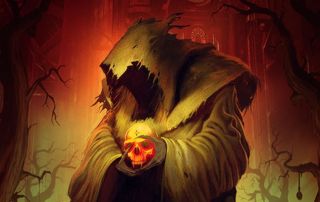
There's a drinking competition at the village inn, and I do like to get drunk in videogames. My half-orc barbarian has the most hit points and the least intelligence, which probably makes him qualified for entry. Half a dozen locals and guests join in, and every time the innkeeper shouts "Drink!" they knock back an ale and drop a bunch of HP (non-fatally, of course). In the end it comes down to the barbarian and a traveler named Kobort, who eventually topples to join the rest of the competitors sleeping on the floor.
Then I have my rogue go round and loot all their stuff. Even clothes. Nobody seems to mind. It's a fair punishment for getting fall-down drunk. They're lucky I'm not drawing schlongs on their foreheads. For the entire rest of the game I recognize NPCs I beat in this competition because they stand around town in their medieval underpants. That's just how it goes in The Temple of Elemental Evil.
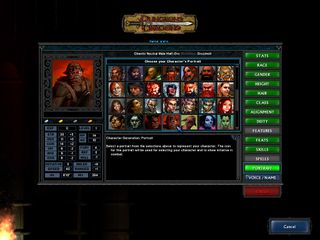
Most sessions of D&D, fun as they are, tend to be more straightforward and less philosophical.
OK, before we go any further—Planescape: Torment is the best Dungeons & Dragons game. It's imaginative, well-written, makes memorable use of wonky concepts like alignment, and has the most interesting companions. But if you've ever played D&D around a table, Planescape: Torment doesn't have much in common with that experience.
Most sessions of D&D, fun as they are, tend to be more straightforward and less philosophical. It's often a beer-and-pretzels game, one where a party of adventurers face danger, fight ridiculous monsters like oozes and bugbears, return to town to sell all the loot and head to the inn. Then they get into a fist fight or a drinking competition or both, and after enough sleep for the magic users to get their spells back, they do it again.
The Temple of Elemental Evil is the videogame that gets closest to recreating that experience. It may not be the best D&D game, but it is the most D&D game.
It helps that The Temple of Elemental Evil is an adaptation of an actual printed adventure written by Frank Mentzer and Gary Gygax (D&D's co-creator). Published in 1985, the book followed on from a 1979 adventure called Village of Hommlet, combining the two into one of the biggest D&D scenarios of the time. The idyllic Hommlet served as a home base from which to explore a moathouse full of bandits, a swampy hive of scum and villainy called Nulb, and the ruined temple itself, each a progressively more difficult challenge. It laid down a format later adventures would follow, so even D&D players who didn't experience the original have probably played something influenced by it.
The videogame builds on that adventure with a literal translation of D&D's then-current 3.5 edition, the ruleset with all its quirks plunked down wholesale, with turn-based combat. Do you know what attacks of opportunity are? Why five-foot steps are important? Trip attacks? You will learn, because The Temple of Elemental Evil uses all those things. It has a manual that's over 150 pages long, including a couple of pages to note where it differs from the official rules by necessity (there's also a recipe for chocolate chip cookies thrown in, because manuals ruled).
The biggest gaming news, reviews and hardware deals
Keep up to date with the most important stories and the best deals, as picked by the PC Gamer team.
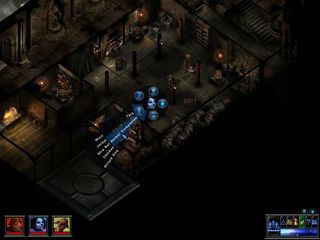
That's a lot of rules to interact with. They're brought onto your screen via a radial menu that appears when you right click. It spirals with bristling options like the tools in an overstuffed Swiss army knife, only instead of nail clippers and a corkscrew they're spells and feats and skills and items. It's ridiculous but also kind of wonderful. Like Blood Bowl, it's a game I can't imagine making sense to people who aren't familiar with the original rules. But, also like Blood Bowl, I love its commitment to replicating those tabletop rules in all their doofy glory.
As well as the rules, The Temple of Elemental Evil recreates the feel of a typical D&D game. It's set in the world of Greyhawk, one of the first D&D settings and the default for several years. Surprisingly this is the only time Greyhawk ever showed up in a videogame, perhaps because it's so generic (though that didn't hold the Forgotten Realms back). It has everything you expect: gnolls, gnomes, giant frogs and characters with unpronounceable names like Zuggtmoy and Spugnoir.
Greyhawk, like the scenarios set there, was originally pretty skeletal, designed to be gap-filled by Dungeon Masters. In the videogame, the designers at Troika did that for us, with exactly the kind of sidequests an eager young DM would create. Before you even get out of Hommlet you're smoothing over family feuds to get marriages happening (and possibly being pushed into marriage yourself), exposing spies from the Temple, and playing both sides of a religious conflict between the local druid of the Old Faith and the shiny new clerics of St. Cuthbert.
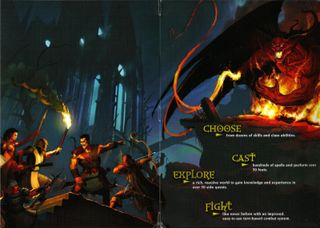
This kind of engagement with characters, all taking place in branching dialogue trees, is what really puts the roleplaying into a roleplaying game. The Temple of Elemental Evil is in the lineage of the early Fallout games (with which it shares lead designer Tim Cain), and it also has a dedication to allowing characters with low Intelligence scores to shine. Ug, that half-orc barbarian of mine, has an Intelligence of 6 and that unlocks unique dialogue options through the entire game. Here's what happens when Ug meets a village NPC.
Leatherworker’s Wife: Nice to meet you, Ug. I am Lisbeth. I am the wife of Jakk here, the town leatherworker.
Ug: He make torn feathers?
Leatherworker’s Wife: No, no. He makes the town leather.
Ug: He makes brown weather? Hehehe. He poop in sky?
These are the kind of jokes you make sitting around a table with your friends, surrounded by dice and junk food. But Ug also gets to have a heartwarming conversation with Hommlet's children about how half-orcs aren't all monsters—at least, after he convinces them that he isn't going to eat them.
Like I said it's no Planescape: Torment, but in moments like this its charm shines through. We'll never get to play The Temple of Elemental Evil the way it was when Gary Gygax ran it for his friends and kids because even the version published in 1985 was modified—Gygax's own map was random, procedural generation via dice and grid paper. Both the published book and the videogame altered that original, but even so they let us get close to some of the source material that made D&D a cultural phenomenon.
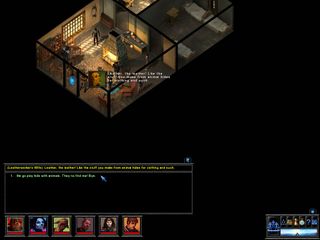
Being alone at a computer isn't the same as sitting round a table shouting every time someone rolls a 20 or putting on a silly voice and making everyone laugh, but The Temple of Elemental Evil gets surprisingly close to recreating that atmosphere. It's a shame it wasn't more popular.
One of the things that held The Temple of Elemental Evil back when it was released in 2003 is that, like Troika's other tabletop RPG adaptation Vampire: The Masquerade – Bloodlines, it came with a lot of bugs. Fortunately it's been patched since, and a group of modders calling themselves the Circle of Eight have released a modpack that tweaks it further. They've added new quests, altered existing ones, and even dropped in a whole new settlement called Verbobonc. Another mod of theirs lets you play through The Keep on the Borderlands, another classic Greyhawk adventure, although it's even tougher than the base game.
I've still never finished exploring The Temple of Elemental Evil, partly because the dungeon's so big and partly because I keep starting over with new characters. D&D's third edition opened up the character options, making previously forbidden things like halfling paladins or wizards with crossbows possible. It's easy to lose an hour or two rolling up an entire party, and there are nine different beginnings, based on which "party alignment" you choose.
Though I may never make it to the bizarre demon queen of fungus who apparently lurks at the bottom of the Temple, I go back to Hommlet's inn on the regular, raising another ale with some guys whose pants I sold.

Jody's first computer was a Commodore 64, so he remembers having to use a code wheel to play Pool of Radiance. A former music journalist who interviewed everyone from Giorgio Moroder to Trent Reznor, Jody also co-hosted Australia's first radio show about videogames, Zed Games. He's written for Rock Paper Shotgun, The Big Issue, GamesRadar, Zam, Glixel, Five Out of Ten Magazine, and Playboy.com, whose cheques with the bunny logo made for fun conversations at the bank. Jody's first article for PC Gamer was about the audio of Alien Isolation, published in 2015, and since then he's written about why Silent Hill belongs on PC, why Recettear: An Item Shop's Tale is the best fantasy shopkeeper tycoon game, and how weird Lost Ark can get. Jody edited PC Gamer Indie from 2017 to 2018, and he eventually lived up to his promise to play every Warhammer videogame.

I desperately hope Dragon Age: The Veilguard, Baldur's Gate 3 and Disco Elysium inspire more RPG devs to reject the traditional drip, drip, drip of DLC and expansions

FF14 is finally fixing the fact my carefully-constructed portraits keep reverting to a goddamn driver's licence photo whenever I change my goddamn gear
Most Popular


